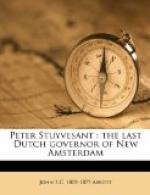An election was ordered and eighteen “of the most notable, reasonable, honest and respectable persons” in the colony were chosen, from whom the governor was to select nine persons as a sort of privy council. It is said that Stuyvesant was very reluctant to yield at all to the people, and that he very jealously guarded the concessions to which he was constrained to assent. By this measure popular rights gained largely. The Nine Men had however only the power to give advice when it was asked. When assembled, the governor could attend the meeting and act as president.
Governor Stuyvesant, soon after his arrival at fort Amsterdam, addressed courteous letters to the governors of all the neighboring colonies. In his letter to Governor Winthrop, of Massachusetts, he asserted the indubitable right of the Dutch to all the territory between the Connecticut and the Delaware, and proposed an interview for the settlement of all difficulties.
An Amsterdam ship, the Saint Benino, entered the harbor of New Haven, and for a month engaged in trade without a license from the West India Company. Stuyvesant, ascertaining the fact, sent a company of soldiers on a secret expedition to New Haven, seized the vessel on the Lord’s day, brought her to Manhattan, and confiscated both ship and cargo.
Emboldened by success, Stuyvesant sent a letter to the authorities at New Haven claiming all the region from Cape Henlopen to Cape Cod as part of the territory of New Netherland, and affirming his right to levy duties upon all Dutch vessels trading within those limits.
Governor Eaton, of the New Haven colony, sent back a remonstrance protesting against the Dutch governor as a disturber of the public peace by “making unjust claims to our lands and plantations, to our havens and rivers, and by taking a ship out of our harbor without our license.”
Three deserters from Manhattan fled to New Haven. Governor Eaton, though bound by treaty obligations to deliver them up, yet indignant in view of what he deemed the arrogant claim of Governor Stuyvesant, refused to surrender them, lest the surrender should be deemed as “done in the way of subordination.” The impetuous Stuyvesant at once issued a retaliatory proclamation in which he said:
“If any person, noble or ignoble, freeman or slave, debtor or creditor, yea, to the lowest prisoner included, run away from the colony at New Haven, or seek refuge in our limits, he shall remain free, under our protection, on taking the oath of allegiance.”
This decree excited strong disapprobation at home as well as in the other colonies. The inhabitants of Manhattan objected to it as tending to convert the province into a refuge for vagabonds from the neighboring English settlements. After a few months the obnoxious proclamation was revoked. But in the meantime Governor Stuyvesant had bribed the runaways, who had been taken into the public service at New Haven, to escape and return home.




